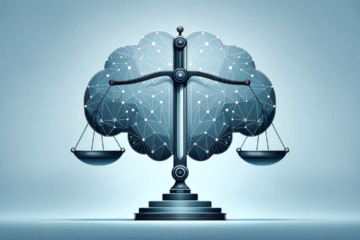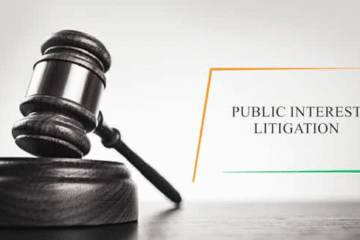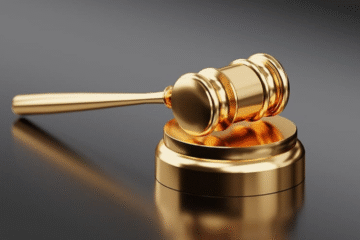This article is written by Paramjeet Kaur of Himachal Pradesh National Law University, an intern under Legal Vidhiya.
INTRODUCTION
It is the ultimate power of the judiciary to review and determine the validity of a law or an order may be described as the powers of “judicial review”. This system in India has been governed by the principal of ‘procedure established by law’ under which it has one test i.e. Whether the law has been made with procedures of law or not, if not will be declared unconstitutional.
Law plays an important role in today’s society. People have given up on their rights and entered into a contract with the government in return of which the government gave them protection against the wrong. This is known as the Social Contract Theory given by Hobbes. In this phase of Rule of Law, the law without justice can become arbitrary and can be misused. So to keep check and balance on the power of each organ of government we have further adopted Judicial Review. Judicial review is the process by which the court declares any law which goes against the constitution as void. We have adopted this feature from the United States Constitution. But it took a lot of years to fix this feature in our constitution. Judiciary has played an important role in this regard. Judicial Review can be of Constitutional Amendments, Legislative actions and of Laws made by the legislature. In this research paper, we will discuss the history, growth, features and types of Judicial Review with Indian case laws.
In India there is a rule of law and the constitution is the supreme law. The Indian constitution is the law of the land and if any law passed violates the basic structure of the constitution the Indian judiciary is having the power to nullify that law. The term judicial review is actually not there in Indian Constitution but many articles are there which gives the clear idea of judicial review in it.
The Indian judiciary are having the powers to examine the actions of legislature, executive, administrative arms of the government and to ensure that such actions should adhere to the provisions of our constitution. If found unconstitutional, the following provision shall be made void.
HISTORICAL VIEW
The most distinctive feature of the united states supreme court is its power of judicial review. As the guardians of the constitution the judiciary is that they can review the laws which may violate the constitution of the country. The power of judicial review was first introduced in the supreme court in the case of Marbury v. Madison (1803) in which the powers of the supreme court was established by limiting the power of the congressional by declaring the legislation unconstitutional.
In this case the court ruled out that the newly elected president of that time and his secretary of state, John Madison was wrong to prevent William Marbury from being the justice of the district court as being appointed by the former president before leaving the office. So, he filed a writ of Mandamus against the secretary of the state. The judiciary Act of 1789 gave the supreme court jurisdiction, but the Marshall court ruled the act of 1789 to be an unconstitutional extension of judiciary.
The Constitution of India is more tilted towards the U.S Constitution in the aspect of this prospect of judicial review than that of Britain. In Britain, no court can declare any law invalid passed by the British parliament whereas in India parliament is not supreme it cannot make and any laws executed there are always under the scope of judicial review.
TYPES OF JUDICIAL REVIEW
Reviews of Legislative Actions:
This review implies the power to ensure that laws passed by the legislature are in compliance with the provisions of the Constitution.
Review of Administrative Actions:
This is a tool for enforcing constitutional discipline over administrative agencies while exercising their powers.
Review of Judicial Decisions:
This review is used to correct or make any change in previous decisions by the judiciary itself.
Importance of Judicial Review:
It is essential for maintaining the supremacy of the Constitution.
It is essential for checking the possible misuse of power by the legislature and executive.
It protects the rights of the people.
It maintains the federal balance.
It is essential for securing the independence of the judiciary.
It prevents tyranny of executives.
Problems with Judicial Review:
It limits the functioning of the government.
It violates the limit of power set to be exercised by the constitution when it overrides any existing law.
In India, a separation of functions rather than of powers is followed.
The concept of separation of powers is not adhered to strictly. However, a system of checks and balances have been put in place in such a manner that the judiciary has the power to strike down any unconstitutional laws passed by the legislature.
The judicial opinions of the judges once taken for any case becomes the standard for ruling other cases.
Judicial review can harm the public at large as the judgment may be influenced by personal or selfish motives.
Repeated interventions of courts can diminish the faith of the people in the integrity, quality, and efficiency of the government.
CONSTITUTIONAL PROVISIONS IN INDIA
The India parliament has adopted this system of judicial review system from US Constitution and the powers of the parliament are not supreme and the power is divided between Centre and the states. The supreme courts also have powers of reviewing the enactments of both the parliament and state legislatures. This makes the courts more powerful and grants an instrument of the judicial review.
The various provisions of the system of judicial review has been granted by our Constitution in various articles. These articles are Article 13, 32, 131-136, 143, 226, 145, 246, 254, 251 and 372. These articles would be explained in brief below:
Article 13 declares that any law which contravenes any of the provisions of the part of the fundamental rights shall be void.
Article 32 provides the right to constitutional remedies which means that a person has the right to move to the supreme court for getting his fundamental rights protected.
Article 226 empowers the high court to issue directions, orders or writs in the nature of habeas corpus, mandamus, quo warranto and certiorari. Such directions, orders or writs may be issued for the enforcement of fundamental rights or any other purpose.
Article 143 confers the power upon the supreme court advisory jurisdiction. The president may seek the opinion of the supreme court on any question of law or fact of public importance on which he thinks it expedient to obtain such an opinion.
Article 372(1) says that all the law in force in the territory of India immediately before the commencement of the constitution shall be in force therein until altered, repealed or amended by a competent legislature or an authority.
Article 131-136 entrusts the courts with the power of adjudicate disputes between individuals, and the state, between the states and the union; but the court may be required to interpret the provisions of the constitution and the interpretation given by supreme court becomes the law honored by all courts of the land.
Article 245 states that the powers of both parliament and states legislature are subject to the provisions of the constitutions. Any legitimacy of any legislation can be challenged before the court of law on that particular subject matter or if the law infringes any o f the fundamental right.
Article 246(3) states that the powers of both parliament and state legislatures are subject to provisions of the Constitution of India.
Article 251 and 254 states that in case of inconsistency between union and state laws, the state laws shall be void.
It must also be kept in mind that there is no express provision in our constitution which empowers the courts to invalidate laws, they are only entrusted with the task of deciding whether the law which is to be implemented is not unconstitutional or not. In case if part of a provision becomes non-operative and other part of that provision continues to be in operation. If the other part in operation cannot be operated without the other part, then the whole of the law gets rejected.
For declaring any law unconstitutional the supreme courts have to properly mention that which part of the provision is unconstitutional then that particular part or the whole of the provision would be repealed from the Indian constitution. When a law is found to be unconstitutional it ceases to operate from the date of the judgement given by the courts. All the previous decisions which were taken before the day of declaration, shall continue to remain valid.
CASES OF JUDICIAL REVIEW IN INDIA
Judicial review can be conducted on both states and central existing laws and the ordinances of both constitutional and executive amendments. Judicial review cannot be conducted on the laws present in the ninth schedule of the Indian Constitution. The interpretations of the supreme court ishonored by every court on the land and thus there is no appeal against the judgement of the supreme court.
In Shankari Prasad v. Union of India the first amendment act of 1951 was being challenged before the supreme court on the ground that ‘Right to Property’ was been abridged by the Act and was argued that it could not be done as the fundamental rights under article 13(2). Supreme court rejected the contention and said that the terms of Article 368 are perfectly general and empower the parliament to amend the constitution without any exception.
The landmark case of Golaknath v. State of Punjab three constitutional amendments were challenged which were 1st, 4th and 17th. The supreme court reversed its decision that parliament under article 368 has no power to amend to take away or abridge the fundamental rights guaranteed under our constitution. The supreme court observed that:
· Article 368 only provides a procedure to be followed regarding amendments of the constitution.
· Article 368 does not actually contain the power to amend the constitution
· The powers to amend the constitution is derived from article 245, 246, 248 and entry 97 of the Union list.
In Sajjan Singh vs State of Rajasthan the 17th Amendment Act of 1964 was in question. The court overturned its own decision in the Shankari Prasad case and held that constitutional amendments made under Article 368 were not within the ambit of judicial review by the courts.
In Minerva mills case the supreme court by a majority of decision struck down section 4 of the 42nd Amendment Act which gave power to the directive principles over article 24, 19, 31 of our constitution. As it would destroy the harmony of the Indian Constitution and stated that part III &IV of our constitution are equally important and absolute primacy of one over other is not permissible.
Thus, interpreting the various provisions of the constitution and helps in proper implication of laws in the country.
CONCLUSION
The system of judicial review is one of the most powerful system of our Indian Constitution. The doctrine of judicial review is thus firmly rooted in India, and has explicit sanctions of the Indian constitution. All the provisions in our Indian clearly mentions the importance of judiciary and helps in keeping a check over the legislative and executive of the Centre as well as states. The system of judicial review act as guardians of protection of our constitution and guarantees individual fundamental rights, divides power between the union and the states and clearly defines the powers of every organ functioning in the country. Thus, legitimizing the actions of the government and the protection of the Indian constitution against any undue encroachment by the government.
With the power of judicial review, the courts act as a custodian of the fundamental rights.
With the growing functions of the modern state, judicial intervention in the process of making administrative decisions and executing them has also increased.
When the judiciary surpasses the line of the powers set for it in the name of judicial activism, it could be rightly said that the judiciary then begins to invalidate the concept of separation of powers set out in the Constitution.
Making laws is the function and duty of the legislature, to fill the gap of laws and to implement them in a proper manner is responsibility of the executive. So that the only work remaining for the judiciary is interpretations. Only a fine equilibrium between these government bodies can sustain the constitutional values.




0 Comments